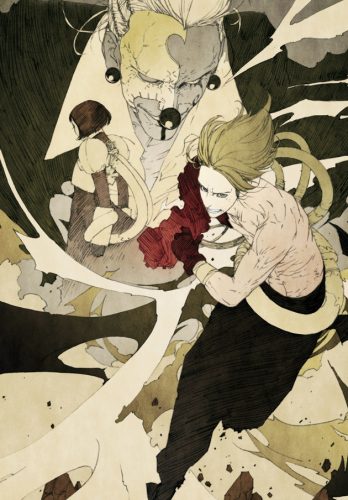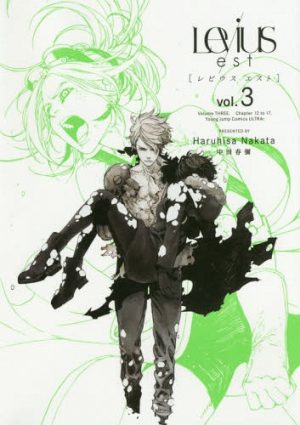
- Mangaka : Haruhisa Nakata
- Publisher : Viz Media
- Genre : Seinen, Action, Sports
- Published : September 17th, 2019
Levius Introduction
In a uchronic world just barely recovering from a devastating war, the people turn to a new kind of bloodlust. The fresh sport of MMA (that is, Mechanical Martial Arts) has become the focus of the world's attention, as athletes, billionaires, and weapons manufacturers undergo mechanical augmentation to fight with deadly prosthetics in hand to hand combat, often to the death.
A young man named Levius begins climbing the ranks of the world’s prime MMA association initially to earn money to support his comatose mother. But his resolve is only further steeled when he sees an opportunity to use his talent to fight against the atrocities of war that still thrive around him.
Contains Spoilers
Discussion Time
Levius should not have worked. Not only is it the manga debut of Haruhisa Nakata whose only other work has been as a character designer on the less-than-well-designed Fairy Gone and initially serialized in a small underground magazine, but it has the distinction of being one of the rare commercially published steampunk series. Investing in any steampunk property is always a gamble since the maligned movement's history is marked by a long string of minor successes and major failures. Despite being established decades ago, steampunk has never had even a single crossover smash hit, still waiting for someone to do to it what Neuromancer and Mad Max did to cyberpunk and dieselpunk respectively. Even Katsuhiro Otomo's ode to the movement—Steamboy—bombed like a nuke only a few years after his opus Akira became an international sensation.
Despite all the odds standing against it, Levius impresses—and at times, even astounds—thanks to a sketchy, yet detailed art style; creative layouts and pulse-pounding action. Unfortunately for steampunk fans, the manga’s shortcomings are likely to stop it from being the crossover hit that will give the genre its first taste of mainstream attention, but followers of the movement will be able to enjoy Levius as one of its best products of recent memory all the same.

1. Lookin’ Steamy
Levius’ artwork succeeds on just about every level. Its character art emphasizes anatomic accuracy far more than most and the urban cityscapes that form its backgrounds are rendered with realism to match, making the series barely look like a manga at times.
On the other hand, all the strengths of manga art are on full display in Levius, most notably through the powerful lines of motion present in the character poses portrayed in its many fight scenes.
2. The Gears are Turning
A steampunk martial arts story seems extremely farfetched, but Levius is able to justify its odd premise by showing off creative uses for the weird pairing. Fighters engage in hand-to-hand combat with specialized gear à la Megalo Box, only powered by steam which the gear creates by evaporating their blood, meaning that more enhancements will do more damage not only to one's opponents but to their own body as well. Artistically, the steam is released by the gear in a way that follows the motion line of each panel, thus drawing the reader's eye to the characters' actions and making them easy to follow. The gears can also shoot compressed steam as a projectile, which would probably only cause burns and skin problems in real life, but instead create destructive energy blasts in the manga. If you’re going to have a steampunk setting, you might as well have some fun with it.
3. Punk Rock ‘Em Sock ‘Em
Seinen battle manga is awesome, but with the exception of stories whose titles begin with Jojo, most of their fight choreography is shown up by their shonen contemporaries. Not so with Levius, however, as it executes its combat in ways more exciting than nearly all currently serialized battle manga.
Every fight takes full advantage of the setting’s wild possibilities and the participants’ unique fighting styles in ways that deepen their characterization. From the desperate wide swings of nearly-retired fighter Malcolm Eden, to the way the villainous Hugo Stratus focuses on fast and heavy offense at the expense of protecting himself and even to the complex way in which our hero Levius Cromwell balances a tactical approach deducing enemy weak points with wanton berserk rampages of attacks, every fight tells us more about those in it than simple text could.
There’s more to these set pieces than character development, though, as the battles are exhilarating even when divorced from the rest of the story. The fact that the series’ seinen status allows it to be more extreme in its violence than those aimed at the younger shonen demographic certainly helps, but the true secret to its success lies in is layouts. By drawing all the panels on his pages with a continuous line of motion, Nakata guides the reader’s eyes from action to action in a manner that makes even the longest protracted sequence flow so smoothly as to be reminiscent of battle manga greats like Dragon Ball.
1. Dragon Ball Zteam
There’s another reason this series is likely to draw comparison to Dragon Ball and that’s because—simply put—Levius cribs its moves. Taking inspiration from Akira Toriyama’s classic is understandably common practice for modern battle manga, but Levius goes one step further by having characters use their steampunk technology to recreate some of the most well-known attacks from Dragon Ball.
You may think it’s just a coincidence when you see the steam-powered kikoho or the first time, but by the time you’ve seen the steam-powered final flash, the fact that the classic moves are being recreated right down to the exact pose will be too clear to ignore. It’s a cute homage on one hand, but an atonal distraction on the other, especially since the steampunk gear used to make these easter eggs is clearly shown to be capable of creating such blasts without the out-of-place posing.
2. An Evaporated Cast
We did say that the fights in Levius are good at fleshing out the cast, but the rest of the story, sadly, isn’t. The characters are—for the most part—far from one-dimensional, but they still aren’t especially compelling, with the eponymous Levius being among the worst examples as he plays the role of an almost completely reactive protagonist outside the ring. He fights whoever the MMA association tells him to fight, he lets the villains dictate the conditions of his matches and while he does step up to pursue his own character motivations on a few refreshing occasions, even these get little development. The most glaring example is Levius’ ambition to cure his mother, it’s one of the first significant things we learn about him and it is not progressed in any way by the end of the series.
The best character is hands down Levius' gear mechanic Bill since his worldview actively drives a lot of the plot all the while undergoing small shifts as he progresses through his character arc, but sadly, little time is spent on him in contrast to the comparatively passive main cast.
3. Something About It Being Steampunk
One of the first things any reader will expect from a steampunk story is good worldbuilding, partially because the possibilities are so numerous and partially because a steampunk setting just raises so many questions.
Why don't people use more contemporary energy sources? Why do the fashion and architecture look so Victorian? Does the setting have any of the sexist, racist or classist systematic oppression inextricably linked to the real Victorian era? How does the reliance on steam engineering affect society at large?
These are the kinds of questions that readers are likely to ask when flipping through a steampunk story and building the world in a way that answers them could make for an extremely compelling read in the hands of the right author, but Levius fails by not even trying.
Outside of the occasional war flashback, nearly all of the manga’s worldbuilding centers around the MMA association and even that is poorly executed. We’re told that fighters are all classified into 5 grades, with the 5th holding the weakest ones and the 1st having only the 13 strongest combatants and then rated by rank within those grades.
The plot’s inciting incident occurs when the 11th ranked fighter in the 1st grade dies mid-bout—keep in mind, killing has been established as an accepted way to claim victory in this league—and martial artists in grade 2 like Levius himself are now able to fight their way to fill in the vacancy. If you’re now asking whether or not the dead fighter was killed by another member of grade 1, why they didn’t just give his title to the unnamed contender that beat him if he wasn’t, or even just how the battle went down, then congratulations, you’ve already put more thought into this plot point than Nakata, because he never explains any of it.
Final Thoughts

The best way to sum up Levius in one sentence would be to say that it consistently displays spectacular visuals in service to a shallow narrative. But Levius’ failings in characterization and worldbuilding never bring down the experience enough to lose audience investment and even if they did, its merits as an action spectacle would still put it above many of its genre contemporaries.
If you love the kinetic battles of manga like Dragon Ball, Naruto or Fire Force and want something aimed at a somewhat more mature audience, you should pick up Levius, because it will be a long time before we see another manga this exciting.
Recommended Post


